Gennaio 2006 - Italia Sud, Calabria
Buon Giorno Amici e Famiglia,
January (gennaio) is here and it is very cold now. I warmed up a bit by taking a trip
to Southern Italy (italia sud) for a week. I visited the region of Calabria (the toe end of the boot),
spent Christmas with an Italian family and then a quick day trip to the island of Sicily.
Southern Italy has many charms, and you can spend a lot of time looking around down there, visiting
various cities, spending time on the beach or visiting ancient ruins and old castles. Of particular interest
to me, was the evidence of ancient Greek colonies.
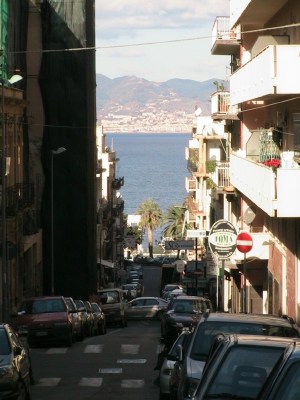
I took a train from Florence to Rome and then all the way down the boot to the toe. My first destination
was the city of Reggio. Reggio is built on a hill that slopes down to the sea (strait of Messina).
I walked all around this city and in the picture above, you can see the island of Sicily in the
background.
Reggio goes back millennia to the Magna Graecia period, during which time it has suffered frequent
invasions and risen from catastrophic earthquakes. One of the biggest tourist destinations in this
city (besides the beach) is the National Museum, which houses a vast collection of finds from
the Magna Graecia period. The centerpieces of the museum are the 2 bronze statues of Riace.
The bronzes of Riace are about 6 feet tall, finely crafted bronze figure sculptures dating back to
the 5th century BC.
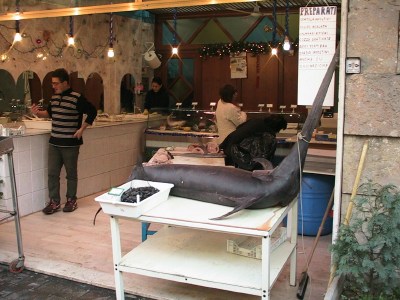
My hotel was about 1.5 Km away from the city center, so I got to walk through lots of side streets.
As in every Italian town or city, there are lots of shops. In Reggio, there were lots of fish shops.
This fish shop has a huge sword fish displayed out front. Later on, they chopped its head off and you
could see just how muscly those things are on the inside.
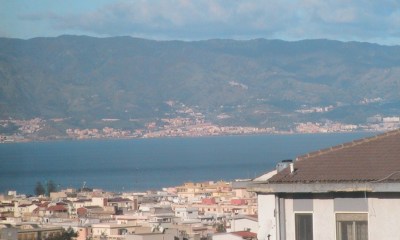
Back at the hotel, I could look out the window and this was the view I got. The city on the other
side of the strait is called "Messina".

A stroll down to the waterfront the next day and looking across the strait of Messina, I could
clearly see Sicily. You don't realize just how mountaneous Sicily is until you see it in real life.
I first thought that was Mt Etna, but the next day when I took a train to my next destination, I could
see Mt Etna, and it made this mountain look like a small hill.
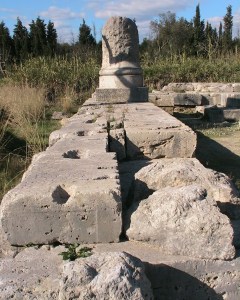
I took trains and buses along the Ionian Sea (mare ionio). I saw lots of pristine beaches and exotic
looking terrain. Two hours later I arrived at the train station in the ancient town of Locri. My host
family greeted me and I was immediately given food. Just outside the town of Locri is an
archeaological excavation of the ancient Greek city that was founded here in approximately 680 BC
(avanti cristo is the Italian way to say before Christ). I walked all around big stone blocks and there
were a few remnants of columns.
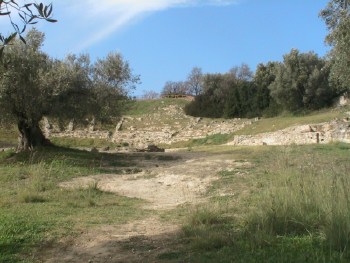
1 Km away from the shoreline lie the remains of the amphitheatre the Greeks built, which the Romans
later built ontop of. I walked along an old country road until I came upon a fence which surrounds the entire
amphitheater. The gate was locked that day, but any tourist with zeal and determination can climb it.
I walked into the lower part of the theatre ...
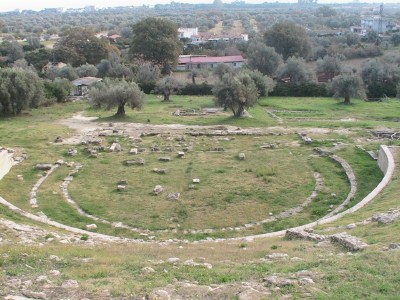
Nobody was there, except me and some gnarley looking olive trees.
I sat and wondered what exotic spectacles had taken place here in times gone by. A short climb up the hill and you can look down
and see the entire complex.
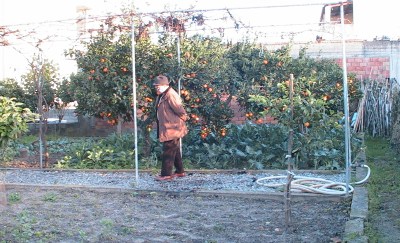
Back at the host's house, the Pisani family was cooking dinner. The man of the house "Fortunato" is a
retired dentist. He was proud to show me the family garden, which is detached from the house and
surrounded by a fence. This garden had orange trees, lemon trees, grapefruit trees and some other
types of plants and trees that I did not recognize. We had fresh orange juice everyday.
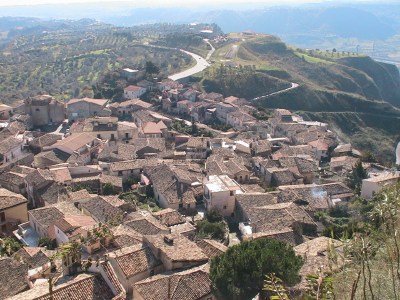
In Locri, if you look up into the hills you can see an old city built on the edge of a sandstone plateau.
A 20 minute drive up winding roads and your in the old city of Gerace. Gerace existed back in Greek times
and has changed it's face through the mellenia to accomodate the various cultures occupying it.
Standing at the southern vantage point of the city and looking down, you can see the "lower town", which
still houses potters' workshops excavated from the rocks, where work is still carried out using the
old Greek system.

At the northern end of the town lies the remains of a 12th century Norman castle.
Looking out from the northern vantage point, you will see the Aspromonte Wilderness.
Small houses with their farms dot the landscape, but fade out quickly as the rugged mountains shrug
them off.
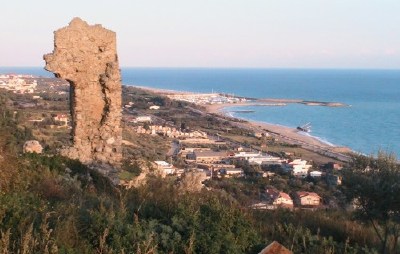

Driving further along the coastline, there are small towns with their own special stories and unique
landmarks.
The town of Roccella Ionica has an old castle above it on the hillside, Castle Carafa (castello carafa).
Walking through the remains of the castle was like taking a step back in time.
Looking out towards the coastline, I could see a ship wreck on the beach. I noticed several of these
along the coastline of the Ionian Sea. This ship must have been some kind of sailing boat, because
you can see the masts. I don't know how long it had been there.
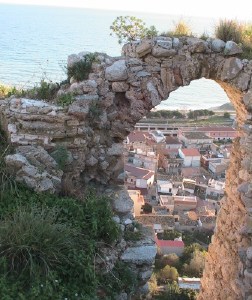
I explored the ruins more and came upon a deteriorating archway that framed the town below.
One step through that doorway would surely result in a horrific fall.

Extending from the plateau the castle is built on, a spiney ridge juts out and there is a circular tower on the end,
the remains of the Angevin Castle. The remains of a housing complex is just below the ridge.
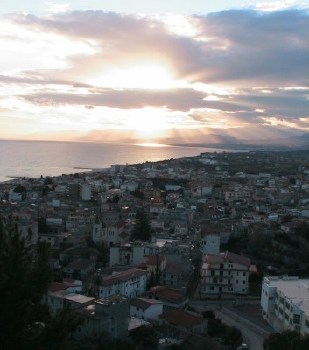
As I walked back to the car, I gazed upon a beautiful sunset over the town of Roccella Ionica.
The weather was good that day and it wasn't necessary to wear a jacket. But at night, the temperature
drops quite a bit and every morning when I awoke and pulled open the curtains, I could see the streets had been doused
with fresh rain.
I said goodbye to the generous host family the next day, took a train back towards Reggio and caught a ferry to the
island of Sicily.
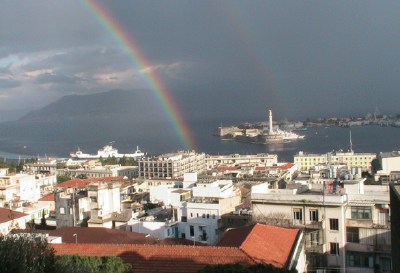
When I arrived in port city of Messina, I had trouble
finding a bus that went to the area where my hotel was located in. So, I just walked. The wheather turned
rainy and I walked for an hour. I was drenched in sweat from carrying two heavy backpacks up steep streets and I had to rest.
I came upon a lookout point that had a large cathedral on it. I got there just
in time to experience a double rainbow.
I didn't spend much time in Messina. It had a couple of long parallel streets with many shops and restaurants.
There were speakers mounted above the main street and American music was playing.
The next day, I ferried back to mainland Italy and then took a Eurotrain to Rome and then to Florence
(which was about 7 1/2 hours total).
I had a window seat and as the train whipped along the seafront (lungomare) just south of the Bay of Naples (Golfo di Napoli),
I couldn't help but notice the very large waves gnawing at the coastline. Old castle remains, quant little towns
and many other places I hope to visit in the coming years passed by my window as I listened to Enya on my iPod.
I arrived "home" in Florence in the evening and saw patches of snow here and there.
Lance Dooley is studying sculpture in Firenze, Italia.
Contact lance at: lance@lancedooley.com
[back to main Italy page]















